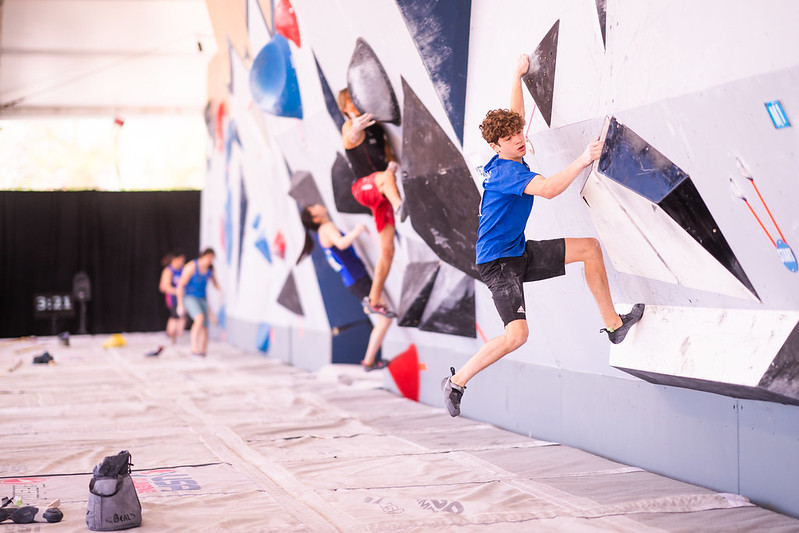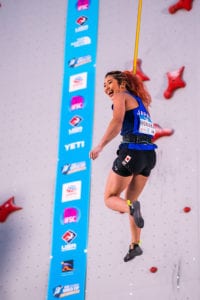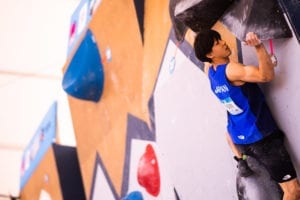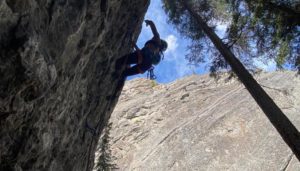World Cup Reflection in Preparation for Innsbruck
Two months after the the first World Cup of 2021, Innsbruck prepares for the fourth Boulder and first Lead World Cup of the season.
 Photo by: Daniel Gajda
Photo by: Daniel Gajda
Just over two months ago, Meiringen hosted what would become a historic Bouldering World Cup. In the past, Switzerland has acted as the kicking-off point for many of the World Cup events, but this years proves unique from them all.

Among COVID regulations, untested athletes, and the prospective Olympic Games, Meiringen, Switzerland hosted an event that show-cased a new generation while simultaneously solidifying the more top positions.
Ultimately, this first point holds more truth than the second. Among the numerous young athletes to make Semis, Oriane Bertone and Mejdi Schalck stood apart from the pack. Each of these athletes would further confirm their ability in the subsequent World Cups in Salt Lake City.
Adding to the odd nature of COVID-era climbing competitions, two Bouldering World Cups were held one week apart in Salt Lake City, Utah. Where Bertone took second in Meiringen, and second again in Salt Lake, Schalck would take twelfth, second and ninth respectively. The greatest take away of these positions do not in fact come from the fact that Team France appears on form, but from the result of their consistent team trainings.
This result was reflected by Team Slovenia and Team USA most noticeably. Following the relocation of Team USA to the National Training Centre, the Americans have appeared on form. Nathaniel Coleman and Natalia Grossman made finals in Meiringen, but only Grossman would maintain her position as one of the strongest female competition climbers in the world across all three World Cups.

Although she would take third in Meiringen, she would win both of the World Cups in Salt Lake City. For the first time in recent history, Slovenia’s Janja Garnbret did not win a Bouldering Final.
This leads into the second point regarding the top of the international field. To begin, Garnbret dominated Finals in Meiringen. The rest of the competition became one for second place. Garnbret would not join the competitors in Salt Lake City for the first of the two Bouldering World Cups.
Although Grossman’s win became a spectacular way to welcome spectators back to international competition, the American’s win crowd did have her victory slightly overshadowed by the fact that Garnbret did not attend. Grossman’s resulting victory the following week solidified her strength in regard to the World Champion. That said, the home field advantage in Salt Lake City was more than a simple expression of support from the crowd.
The American style of route setting at Salt Lake did create proper separation in both the first and second World Cups; however, the second Women’s Final was ultimately separated by attempts as both Garnbret and Grossman completed all four boulder problems.

Naturally, attempts are a reasonable form of separation; however, to make a projection stating Grossman stronger or better than Garnbret seems foolhardy. Ultimately that details of their final placements, however you flip them, show the Grossman has become extremely strong.
This trend of Americans competing well in Salt Lake continued through the length of both World Cups among both categories. It denoted two things: the Americans have become extremely strong as a team; the Americans have become more proficient at the American style of route setting than most of the rest of the field. This last point becomes important as American Garrett Gregor will set at the Olympic event in Tokyo.
Concerning favourites, it could appear that Janja Garnbret would win in Tokyo. That does remain a possibility. With that said, Boulder only offered one of the two Sport Climbing events hosted in Salt Lake City. The second Salt Lake World Cup hosted Speed before Bouldering. At this event, Japan’s Miho Nonaka took third while Garnbret took fifteenth. That said, Garnbret’s best time came close to Nonaka’s, she simply fumbled her Final run.

The head-to-head format of Speed Finals turns the competition into something more like a regular climbing competition. Although getting the best time will necessitate a victory, the mentality behind winning a head-to-head versus a best-time race features opportunity for weaker Speed athletes to reach higher up the rankings.
For athletes like Nonaka and Garnbret, two women at the top of their field, every discipline will matter for taking first position. If, for example, Nonaka took first in Lead and Garnbret first in Bouldering, Speed would become the deciding factor. This level of closeness at the top of the field is further reflected by the Men’s category.
While Czech climber Adam Ondra and Japan’s Tomoa Narasaki have not competed against each other since 2019, the two have become Olympic favourites in Tokyo. Although Narasaki only took third in Salt Lake City, he did take first in the Japan Combined Cup.

The Combined Cup featured both Lead and Boulder, but in a separate Speed event he ran a 5.9. That time offer Narasaki a strong place for Speed Finals and, at the time, could reasonably win the Speed round given that he climbs perfectly and his opponent makes a mistake.
With that said, Ondra’s consistency has gone unmatched, even coming out of quarantine. As the first Men’s competitor to win back to back Bouldering World Cups in several years. The two competitors offer wildly different strengths. Where Ondra offers consistency, Narasaki shows unmatched strengths among the other Olympic competitors.
On June 26, Ondra and Narasaki will compete against each other for the first time since Hachioji. The Lead and Boulder events will afford spectators the opportunity to draw their final pre-Olympic competition. The event will be held in Innsbruck.



